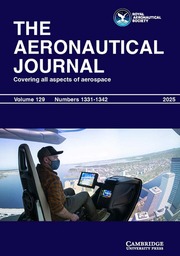No CrossRef data available.
Article contents
Novel synthesis optimisation framework based on performance prediction model for a space propulsion system
Published online by Cambridge University Press: 27 August 2025
Abstract
This article aims to introduce a novel synthesis optimisation framework based on a performance prediction model for a space propulsion system. The structure of this research is divided into five steps for optimisation. In the first step, the optimisation problem is defined, and the objective functions, design parameters and constraints of the problem are determined. This system consists of five sub-systems including (gas tank, liquid fuel tank, injector, catalytic bed and nozzle). In this optimisation, the objective functions include increasing the specific impulse and reducing the overall mass of the system. Also, the design parameters and limitations of each subsystem are mentioned in the text. The optimisation space is extracted in the second step using the design of experiments (DoE) tool and the Latin hypercube sampling (LHS) method. In the third stage, using the design points obtained from the DoE, the metamodel of the mass of each of the sub-systems and the metamodel of the specific impulse of the whole system are produced by the Kriging method. In the fourth step, the metamodels produced are optimised using the SHERPA algorithm based on the objective functions of the problem. In the fifth step, the results are derived by comparing two objective functions (minimum mass and maximum specific impulse for the entire system) using the Pareto front diagram. Finally, by comparing the optimal results with an existing thruster sample, it shows that the specific impulse has increased by 6% and the total mass of the system has decreased by 15.8%.
Keywords
Information
- Type
- Research Article
- Information
- Copyright
- © The Author(s), 2025. Published by Cambridge University Press on behalf of Royal Aeronautical Society


